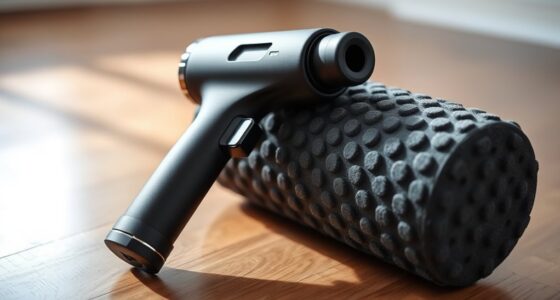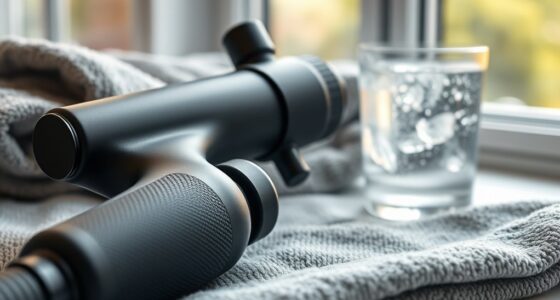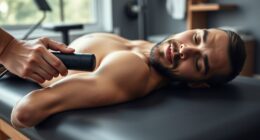To build the ultimate recovery routine, combine stretching and percussion therapy for maximum benefits. Stretching elongates muscles, improves flexibility, and promotes blood flow, while percussion therapy delivers targeted beats to release muscle knots and reduce soreness quickly. Using both techniques together enhances circulation and deepens relaxation, speeding up recovery. Incorporating proper hydration after each session supports this process even more. Keep exploring how these methods work together to optimize your muscle health and recovery.
Key Takeaways
- Incorporate foam rolling and hydration post-workout to prepare muscles for stretching or percussion therapy.
- Use percussion therapy before stretching to enhance muscle relaxation and increase blood flow.
- Combine stretching and percussion therapy for deeper muscle release and improved flexibility.
- Prioritize hydration to maximize the benefits of both stretching and percussion techniques.
- Tailor your routine by alternating between gentle stretching and percussion to target specific muscle needs.

Have you ever wondered which method is more effective for muscle recovery and flexibility—stretching or percussion therapy? The answer isn’t black and white, but understanding how these techniques work together can help you craft a more efficient routine. After any workout, your muscles are vulnerable to tightness and soreness, making recovery essential. That’s where post workout hydration and foam rolling come into play, offering benefits that complement either stretching or percussion therapy.
Proper hydration after exercise is vital because it helps flush out metabolic waste and replenishes fluids lost through sweat. When you’re well-hydrated, your muscles are more receptive to recovery methods, reducing stiffness and speeding up repair. Foam rolling benefits are especially noticeable when paired with good hydration; it can break down adhesions in muscles and fascia, releasing tension and increasing blood flow. Using a foam roller regularly enhances flexibility over time and prepares your muscles for stretching or percussion therapy, making these methods more effective.
Stretching, especially when done after a workout, elongates muscles and improves range of motion. It’s a gentle way to relax tight muscles and prevent future injuries. When you stretch, you encourage blood flow to the muscles, which accelerates recovery. But stretching alone isn’t always enough to address deep muscle tightness or trigger points. That’s where percussion therapy shines. Using a percussion massager delivers rapid, targeted pulses deep into muscle tissue, reducing knots and increasing circulation more efficiently than traditional stretching alone.
While stretching is excellent for maintaining flexibility and calming the nervous system, percussion therapy offers immediate relief from muscle soreness and tightness. Combining both can give you a balanced recovery approach. Before stretching, it’s often beneficial to use percussion therapy to loosen tight muscles, making stretching more effective. Conversely, after stretching, percussion therapy can help reinforce the benefits by deepening muscle relaxation and promoting blood flow.
Incorporating post workout hydration and foam rolling benefits into your routine sets the foundation for better recovery, regardless of whether you prefer stretching or percussion therapy. Staying hydrated ensures your muscles are primed to respond, while foam rolling prepares your tissues for deeper work. Additionally, integrating proper recovery techniques like foam rolling and percussion therapy can enhance the overall benefits of your routine. Whether you lean towards gentle stretching or advanced percussion therapy, understanding how these elements work together helps you build a recovery routine that keeps you flexible, reduces soreness, and enhances overall muscle health.
Frequently Asked Questions
Can Stretching or Percussion Prevent Future Injuries?
You might wonder if stretching or percussion can prevent future injuries. While they can help with injury prevention and performance enhancement, they aren’t foolproof. Regular stretching increases flexibility, reducing strain, and percussion therapy helps release muscle tension, promoting quicker recovery. Incorporating both into your routine supports overall muscle health, lowers injury risk, and boosts performance. Consistency and proper technique are key for these methods to effectively contribute to injury prevention and performance enhancement.
How Long Should Each Recovery Method Be Applied?
Your recovery routine’s effectiveness hinges on following the right duration guidelines, so don’t underestimate its power! For ideal timing, stretch for 10-15 minutes after workouts to improve flexibility, while percussion therapy sessions should last about 1-2 minutes per muscle group for relief. Adjust based on comfort and needs, but keep consistency. Proper timing maximizes benefits, helping you recover faster and prevent injuries.
Are There Specific Muscle Groups Better Suited for Percussion?
You’ll find percussion therapy works best for larger, dense muscle groups like your quads, hamstrings, and calves because of muscle specificity. It effectively stimulates blood flow and relaxes tight tissues, making it a highly effective recovery method for these areas. For smaller or more sensitive muscles, gentle stretching might be better. Tailoring your percussion use to muscle size and therapy effectiveness guarantees you obtain the most benefit from your recovery routine.
Can Combining Stretching and Percussion Enhance Recovery?
Think of combining stretching and percussion like a symphony working in harmony. By integrating these methods, you can boost dynamic flexibility and promote muscle relaxation more effectively than alone. Percussion helps loosen tight muscles, making stretching more beneficial, while stretching prepares your muscles for percussion therapy. Together, they create a balanced recovery routine, reducing soreness and enhancing overall muscle health efficiently and dynamically.
Are There Risks Associated With Percussion Therapy?
You should know that percussion therapy can have risks, especially if used improperly. It may cause muscle soreness or discomfort if applied too aggressively. Also, it can affect your circulatory system, potentially leading to dizziness or bruising. Always follow instructions carefully, avoid overuse, and consult a healthcare professional if you have underlying health conditions to guarantee safe and effective recovery.
Conclusion
Ultimately, whether you choose stretching or percussion, remember that you’re forging a recovery routine powerful enough to tame even the most stubborn muscle knots. Stretching offers gentle flexibility, while percussion delivers a thunderous release—like a storm calming after chaos. Combining both creates an unstoppable duo, transforming your recovery into a legendary ritual. Embrace this dynamic duo, and watch your muscles become invincible, ready to conquer any challenge that comes your way.









